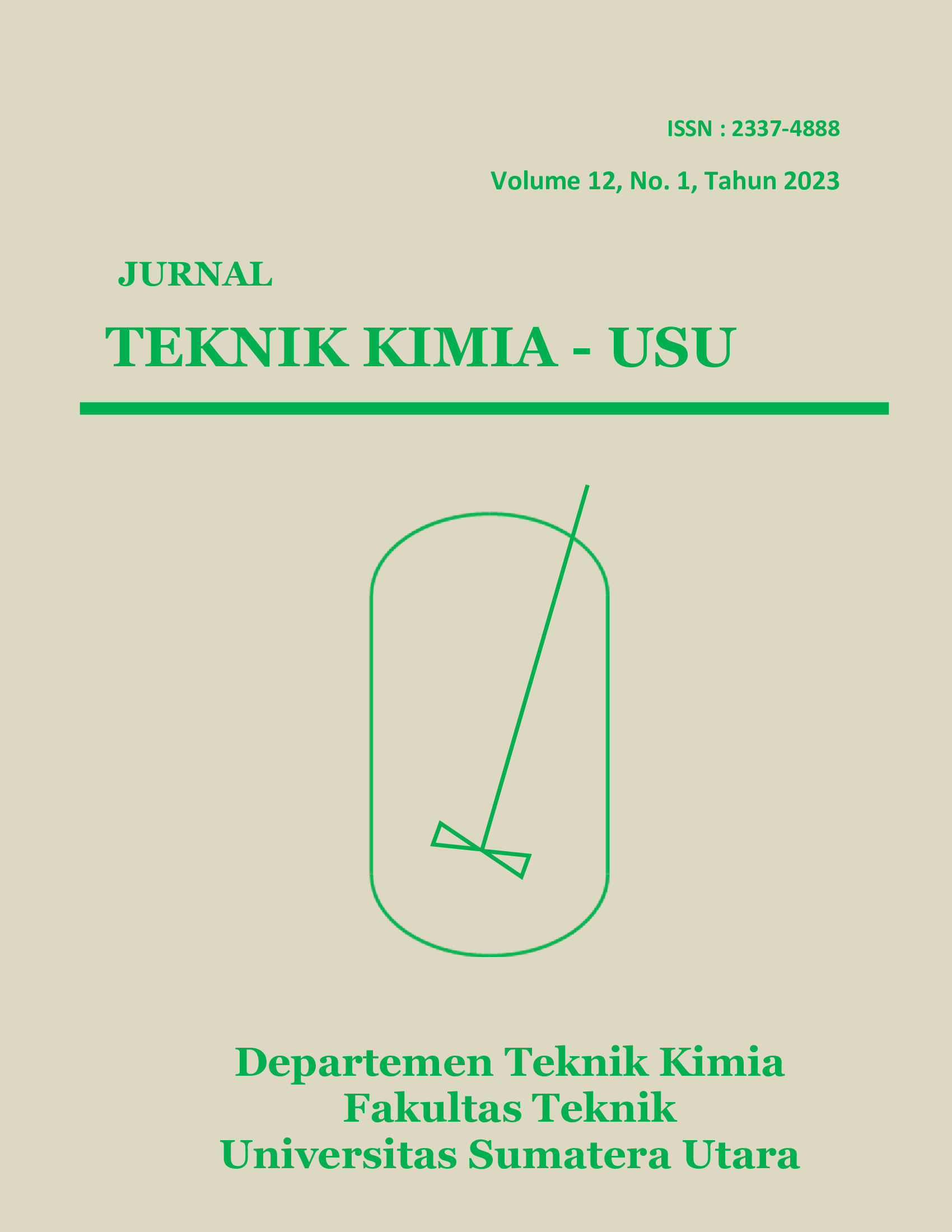Pengaruh Suhu dan Waktu Pirolisis terhadap Karakteristik Arang dari Tempurung Kelapa
DOI:
https://doi.org/10.32734/jtk.v12i1.8534Keywords:
charcoal, biomass, lignin, pyrolysis, coconut shellAbstract
The increased production of coconut has increased by the shell produced, even though this coconut shell has lignin content of 33.30% so it has the potential to be converted into charcoal through the pyrolysis process. Pyrolysis is a thermal decomposition process that occurs without air or with little air to convert biomass into charcoal. Coconut shell charcoal can be used for coal co-firing in developing new and renewable energy. This study aimed to obtain the best pyrolysis temperature and time in the manufacture of high-calorific value coconut shell charcoal in accordance with SNI 06-4369-1996. Coconut shell pyrolysis was carried out at temperatures of 350 °C, 450 °C and 550 °C and pyrolysis times of 2 hours, 3 hours and 4 hours. The results showed that charcoal with the highest calorific value was produced at a temperature of 450 °C and a pyrolysis time of 3 hours. The resulting charcoal had calorific value of 7,750.96 cal/g, yield of 30.10%, and contained 2.75% water, 2.70% ash and 9.50% volatile matter.
Downloads
References
S. Suganal and G. K. Hudaya, “Bahan bakar co-firing dari batu bara dan biomassa tertorefaksi dalam bentuk briket (skala laboratorium),†J. Teknol. Miner. dan Batu bara, vol. 15, no. 1, pp. 31–48, 2019.
F. Khademi and I. Yildiz, “Energy and Solid Wastes,†Compr. Energy Syst., vol. 1–5, pp. 980–1020, 2018.
Anonim, “Kebijakan Energi Nasional.†Presiden Republik Indonesia, Jakarta, pp. 1–8, 2006.
Sudarlin, “Eksplorasi Energi Pengembangan Energi Terbarukan,†in Omah Ilmu, 1st ed., Omah Ilmu, 2016, p. 1.
Sudding and Jamaluddin, “The processing of coconut shell based on pyrolysis technology to produce reneweable energy sources,†Int. Conf. Math. Sci. Technol. Educ. their Appl., no. October 2016, pp. 498–510, 2016.
Anonim, Statistik Perkebunan Indonesia Kelapa, 2018th–2020th ed. Jakarta: Direktorat Jendral Perkebunan, 2019.
A. Irawan, S. Latifah Upe, and I. P. Meity Dwi, “Effect of torrefaction process on the coconut shell energy content for solid fuel,†AIP Conf. Proc., vol. 1826, no. March 2017, 2017.
A. G. Daful and M. R Chandraratne, Biochar Production From Biomass Waste-Derived Material. Elsevier Ltd., 2020.
F. Ronsse, S. van Hecke, D. Dickinson, and W. Prins, “Production and characterization of slow pyrolysis biochar: Influence of feedstock type and pyrolysis conditions,†GCB Bioenergy, vol. 5, no. 2, pp. 104–115, 2013.
R. P. Kumar, B. Bharathiraja, R. Kataki, and V. S. Moholkar, Biomass Valorization to Bioenergy. Singapore: Springer Nature, 2020.
P. Lempp, “Biomass co-firing in coal power plants,†IEA-ETSAP IRENA, Technol. Br. E, vol. 21, p. 2013, 2013.
J. R. Arcate, “Biomass charcoal co-firing with coal,†Proc. ASME Turbo Expo, vol. 3, 1998, doi: 10.1115/98-GT-226.
P. Basu, Biomass gasification, pyrolysis and torrefaction: Practical design and theory. Academic press, 2018.
M. J. Gronnow et al., “Torrefaction/biochar production by microwave and conventional slow pyrolysis - comparison of energy properties,†GCB Bioenergy, vol. 5, no. 2, pp. 144–152, 2013.
SNI 06-4369-1996, “Bubuk arang tempurung kelapa,†Jakarta, 1996.
A. Singh, A. K. Biswas, R. Singhai, B. L. Lakaria, and A. K. Dubey, “Effect of pyrolysis temperature and retention time on mustard straw derived biochar for soil amendment,†J. Basic. Appl. Sci. Res, vol. 5, no. 9, pp. 31–37, 2015.
S. Sadaka, M. A. Sharara, A. Ashworth, P. Keyser, F. Allen, and A. Wright, “Characterization of biochar from switchgrass carbonization,†Energies, vol. 7, no. 2, pp. 548–567, 2014.
K. D. L. F. Lestari, R. D. Ratnani, Suwardiyono, and N. Kholis, “Pengaruh waktu dan suhu pembuatan karbon aktif dari tempurung kelapa sebagai upaya pemanfaatan limbah dengan suhu tinggi secara pirolisis,†J. Inov. Tek. Kim., vol. 2, no. 1, pp. 32–38, 2017.
D. Lestari, M. A. Asy’ari, and R. Hidayatullah, “Geokimia batu bara untuk beberapa industri,†J. POROS Tek., vol. 8, no. 1, pp. 1–54, 2016.
N. Claoston, A. W. Samsuri, M. H. Ahmad Husni, and M. S. Mohd Amran, “Effects of pyrolysis temperature on the physicochemical properties of empty fruit bunch and rice husk biochars,†Waste Manag. Res., vol. 32, no. 4, pp. 331–339, 2014.
S. Wardani, Pranoto, and D. A. Himawanto, “Kinetic parameters and calorific value of biochar from mahogany (Swietenia macrophylla King) wood pyrolysis with heating rate and final temperature variations,†AIP Conf. Proc., vol. 2049, 2018.
S. Siahaan, M. Hutapea, and R. Hasibuan, “Penentuan kondisi optimum suhu dan waktu karbonisasi pada pembuatan arang dari sekam padi,†J. Tek. Kim. USU, vol. 2, no. 1, pp. 26–30, 2013.
Rahmadani, F. Hamzah, and F. H. Hamzah, “Pembuatan briket arang daun kelapa sawit (Elaeis guineensis Jacq.) dengan perekat pati sagu (Metroxylon sago Rott.),†Jom Faperta UR, vol. 4, no. 1, pp. 1–11, 2017.
N. Iskandar, S. Nugroho, and M. F. Feliyana, “Uji kualitas produk briket arang tempurung kelapa berdasarkan standar mutu SNI,†J. Ilm. Momentum, vol. 15, no. 2, 2019.
W. Kusuma, A. Sarwono, and R. D. Noriyati, “Kajian eksperimental terhadap karakteristik pembakaran briket limbah ampas kopi instan dan kulit kopi (studi kasus di pusat penelitian kopi dan kakao Indonesia),†J. Tek. Pomits, pp. 2–4, 2013.
E. Junary, J. P. Pane, and N. Herlina, “Pengaruh suhu dan waktu karbonisasi terhadap nilai kalor dan karakteristik pada pembuatan bioarang berbahan baku pelepah aren (Arenga pinnata),†J. Tek. Kim. USU, vol. 4, no. 2, 2015.
K. E. A. Putra, D. N. K. P. Negara, and C. I. P. K. Kencanawati, “Pengaruh waktu karbonisasi terhadap karakteristik karbon aktif bambu swat (Gigantochloa verticillata),†J. Ilm. Tek. DESAIN Mek., vol. 7, no. 4, pp. 335–340, 2018.
L. Efiyanti, S. A. Wati, D. Setiawan, S. Saepuloh, and G. Pari, “Sifat kimia dan kualitas arang lima jenis kayu asal kalimantan barat,†J. Penelit. Has. Hutan, vol. 38, no. 1, pp. 45–56, 2020.
Downloads
Published
Issue
Section
License
Copyright (c) 2023 Jurnal Teknik Kimia USU

This work is licensed under a Creative Commons Attribution-ShareAlike 4.0 International License.

















